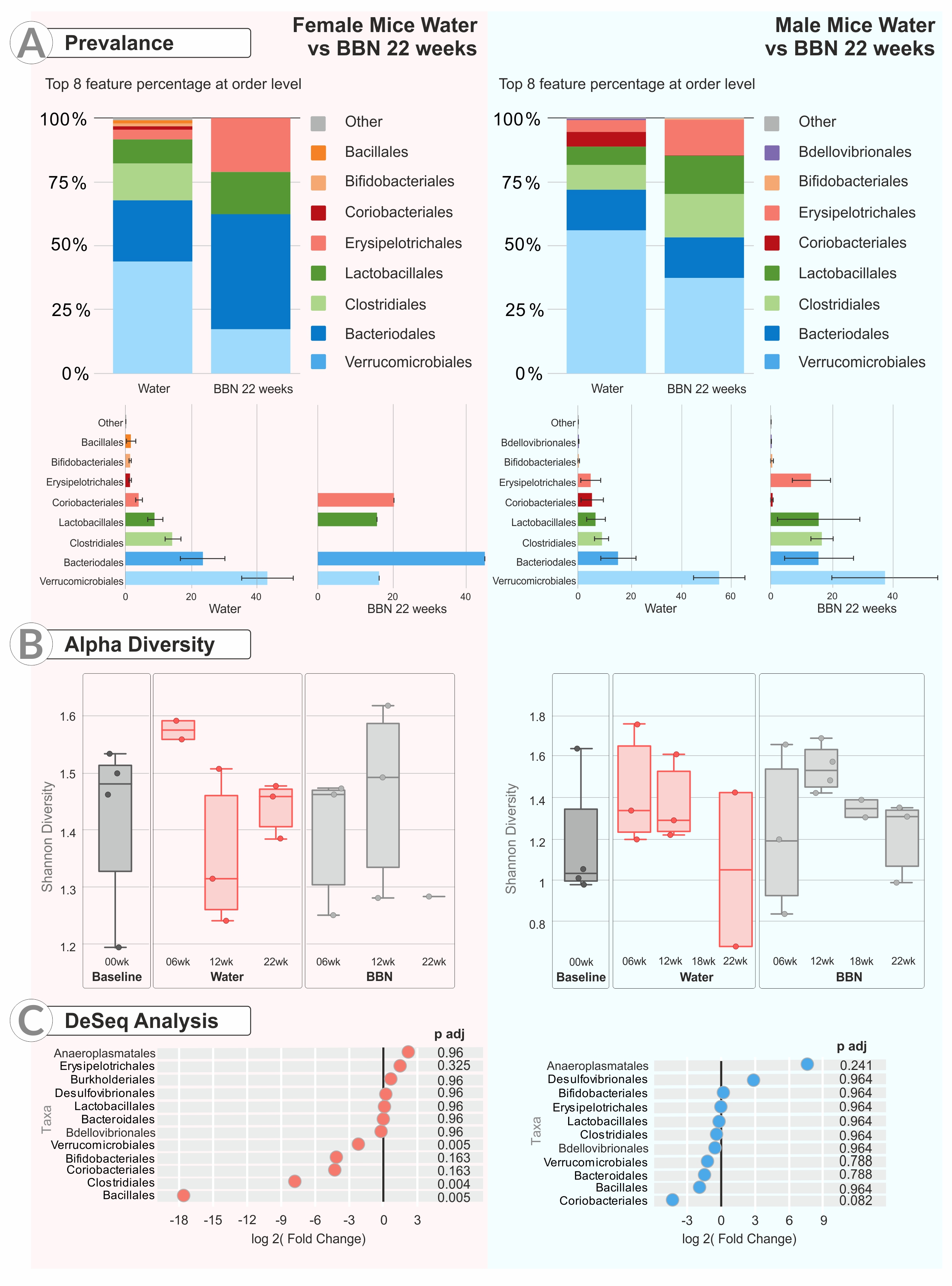Back
Poster, Podium & Video Sessions
Podium
PD53: Bladder Cancer: Basic Research & Pathophysiology III
PD53-06: Changes in mouse stool microbiome with exposure to bladder carcinogen N-butyl-N-(4-hydroxybuytl) nitrosamine (BBN): Longitudinal analysis
Monday, May 16, 2022
7:50 AM – 8:00 AM
Location: Room 255
Rashida Ginwala, Laura Bukavina*, Alexander Kutikov, Philadelphia, PA, Ilaha Isali, Cleveland, OH, Mohit Sindhani, Delhi, India, Megan Prunty, Cleveland, OH, Philip Abbosh, Philadelphia, PA
- LB
Podium Presenter(s)
Introduction: The tobacco BBN is a commonly used carcinogen to model bladder cancer in rodents. The effect of tobacco on the gut microbiome is not well characterized. We used the BBN model to measure its effects on the gut microbiome given the emerging impact on carcinogenesis and therapeutic response in many types of tumors.
Methods: Starting at 8-12 weeks of age, male (N=33) and female (N=22) C57BL/6 mice were administered 0.05% BBN in drinking water for 12 weeks then switched to regular water. Controls limited to water. Stool was collected pre-exposure, after 6 and 12 weeks of exposure, and at the time of tumor identification. DNA extracted from stool was subjected to 16S PCR amplification of the bacterial 16S rRNA. Hierarchical clustering (PCoA), Shannon diversity index was used to quantify and compare microbial diversity across samples and time. In addition bacterial log abundance was calculated.
Results: Distinct clustering difference were present as determined by principal coordinate analysis (PCoA) across sex(p=0.024), but not BBN (p=0.86). Across all the BBN samples, estimation of abundance revealed an relative increase in bacterial populations of Bacteroidales (53%), Lactobacillales (17.5%), Coriobacteriales (19.87%) in females, while male mice exhibited an increase in Erysipelotrichales (14.76%). Bacterial order log abundance demonstrated Clostridiales (log change -7.79, padj <0.004), Veeruccomicrobiales (log change -2.21, padj <0.005), Bacillales (log -17.60, padj =0.005) were detected at a lower prevalence in BBN stool samples as compared to controls in females only, while male mice exhibited no significant differences.
Conclusions: Pronounced microbial changes occur within stool induced by BBN in the murine model, with microbiome of the female mice exhibiting more significant flunctuations, suggesting a difference in BBN effect and metabolism across sex.
Source of Funding: n/a

Methods: Starting at 8-12 weeks of age, male (N=33) and female (N=22) C57BL/6 mice were administered 0.05% BBN in drinking water for 12 weeks then switched to regular water. Controls limited to water. Stool was collected pre-exposure, after 6 and 12 weeks of exposure, and at the time of tumor identification. DNA extracted from stool was subjected to 16S PCR amplification of the bacterial 16S rRNA. Hierarchical clustering (PCoA), Shannon diversity index was used to quantify and compare microbial diversity across samples and time. In addition bacterial log abundance was calculated.
Results: Distinct clustering difference were present as determined by principal coordinate analysis (PCoA) across sex(p=0.024), but not BBN (p=0.86). Across all the BBN samples, estimation of abundance revealed an relative increase in bacterial populations of Bacteroidales (53%), Lactobacillales (17.5%), Coriobacteriales (19.87%) in females, while male mice exhibited an increase in Erysipelotrichales (14.76%). Bacterial order log abundance demonstrated Clostridiales (log change -7.79, padj <0.004), Veeruccomicrobiales (log change -2.21, padj <0.005), Bacillales (log -17.60, padj =0.005) were detected at a lower prevalence in BBN stool samples as compared to controls in females only, while male mice exhibited no significant differences.
Conclusions: Pronounced microbial changes occur within stool induced by BBN in the murine model, with microbiome of the female mice exhibiting more significant flunctuations, suggesting a difference in BBN effect and metabolism across sex.
Source of Funding: n/a


.jpg)
.jpg)